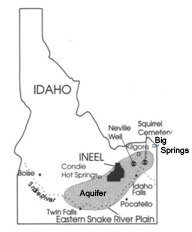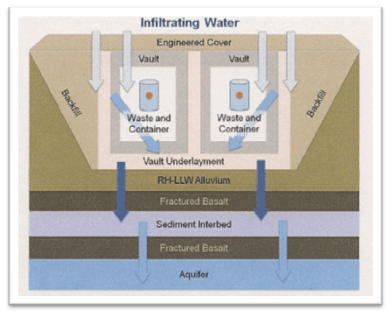Click or scroll down.
More Buried Waste in INL's Future?
Aquifer Contamination
INL CERCLA Cleanup
INL formerly called INEEL is currently undergoing Superfund cleanup of its 368 contamination sites estimated to cost (FY-2012) $33 billion. INL has released over 40 million curies of radioactivity into the environment over its history. Hundreds of millions of curies of radioactive waste are in unsafe dumps and storage facilities at the site. The State and EPA are not fully exercising their enforcement role by allowing significant amounts of radioactive and hazardous waste to remain in INL's dumps. Consequently, public participation is essential to keep the enforcement agencies from allowing DOE to take cleanup short cuts. EDI is advocating for INL environmental restoration through its interaction with federal (EPA) and state (Idaho Department of Environmental Quality) enforcement agencies to ensure substantive public participation and oversight throughout the cleanup and restoration process.
- EDI 2016 Earth Day Report describing the "Forever" Contamination Sites at the Idaho National Laboratory, 04/23/16
- See the government's Institutional Controls Report that lists dozens of Idaho National Laboratory contamination sites that require thousands of years of controls to maintain signs, fences and soil caps to keep radionuclides from blowing in the wind that were shallowly buried and to keep people from growing crops, digging a basement, or drinking water after cleanup is complete.
DOE and enforcement agencies are not providing candid information upon which the public can make informed decisions. A vast number of CERCLA cleanup documents are online at ar.icp.doe.gov yet the extent that cleanup remedies at the Idaho National Laboratory will never meet cleanup standards is often obscured. The continued finding of new CERCLA sites at INL is also obscured. And the many mistakes made along the way are carefully omitted or downplayed such as the inadequate aquifer monitoring at the ATR Complex (formerly Test Reactor Area), inadequate characterization of radionuclide inventory in the soil at the ATR Complex which invalidates the analysis of the proposed replacement for the Radioactive Waste Management Complex to be located at the ATR Complex, and the inadequate investigation of past disposal well practices at the ATR Complex.
The CERCLA administrative record hides the fact that it fails to consider radioactive waste migration after 10,000 years at the Radioactive Waste Management Complex, waste migration that was modeled to delay migration largely until after 10,000 years. Then after 10,000 years, the aquifer contamination levels skyrocket and stay elevated for hundreds of thousands of years. The radiation ingestion doses will be 100 mrem/yr unless the soil cap is perfectly maintained throughout millenia in which case the doses are assumed to be an impossibly steady 30 mrem/yr. The doses estimates are not conservative and will rise whenever precipitation or flooding increases water infiltration.
EDI is attempting to fill this gap by providing information to the public through its EDI News letter, Citizens Guide to INL, past INL Cleanup analysis reports and current INL CERCLA cleanup reports listed here.
- EDI Review of Idaho Nuclear Technology and Engineering Center CERLCA Cleanup, 2016
- EDI Review of INTEC CERLCA Cleanup - Attachment A (ILWMS tanks)
- EDI Review of INTEC CERLCA Cleanup - Attachment B (Grout)
- EDI Review of Test Area North CERCLA Cleanup, 2016
- EDI Review of Auxilliary Reactor Area (ARA) CERLCA Cleanup
- EDI Review of Radioactive Waste Management Complex CERLCA Cleanup
- EDI Review of Engineering Test Reactor, TRA Retention Basin and Materials Test Reactor CERCLA Cleanup
- EDI Review of ANL-W (Materials and Fuels Complex) CERCLA Cleanup, 12/10/15
- EDI Review of the ATR Complex (formerly the Test Reactor Area or TRA) CERCLA Cleanup, 1/8/16
EDI is gaining documents through the Freedom of Information Act that are providing a profile of the fifty-year INL operating history. This information was previously unavailable to the public. Many years of intensive FOIA negotiations and litigation resulted in partial release of these records.
INL Spent Nuclear Fuel Storage
More Buried Waste in INL's Future?

Radiological waste burial practices at INL are not protective of the environment and will continue to
contaminant Idaho's sole source Snake River Plain Aquifer. Waste buried at the Radioactive Waste Management Complex includes large
quantities of the radioactive material in spent fuel (enriched and depleted uranium and fission products); actually, it contains discarded
spent fuel from experiments, accidents and other processing.

DOE's proposed new replacement of RWMC, the Replacement Remote-Handled Low-Level Waste Facility is a permanent disposal facility that will leach radionuclides into the ground and aquifer for thousands of years. The concrete vaults have holes in the bottom to prevent water buildup. The metal canisters are expected to corrode and release the contaminants.
The timeframe for leaching contaminants is hundreds of thousands of years. The analysis ignores inevitiable variations in precipitation and flooding in order to produce the appearance of a steady trickle of contaminants, not exceeding regulatory thresholds.

In addition to continued radioactive waste burial at INL's Radioactive Waste Management Complex and the proposed new Replacement Remote-Handled Low-Level Waste disposal facility, the INL remains short-listed for DOE's Greater-Than-Class-C repository. This waste includes DOE GTCC waste and the commerical nuclear industry waste DOE will become the owner of. This waste placed in the ground, whether or not in metal cans, permanently.
DOE can finalize its Greater-Than-Class-C Low-Level Waste environmental impact statement (EIS) now that public comment was taken. DOE's draft EIS for GTCC waste assessed various locations around the country including INL. DOE can now finalize its report and select along with Congress who will take the country's long-lived waste from commercial reactors, DOE operations, and other waste generators. See more at DOE's GTCC EIS
Interestingly, DOE's draft EIS had conservatisms that made INL's contaminant migration and subsequent dose relatively high. But more recent INL contaminant migration studies have produced estimates of slower contaminant migration and radiation dose, see INL's assessment of its Replacement RH-LLW facility. Hanford already has so many long-lived contaminants, it appears not viable. So, INL cannot be ruled out as a place for this waste.
Other waste facilities at INL are called temporary where highly radioactive waste is placed in cans in the ground, awaiting a plan to retrieve the waste after finding a permanent home for the waste. Buried cans are located at INL's INTEC (formerly for fuel reprocessing) and the Materials and Fuels Complex, formerly Argonne National Laboratory-West (ANL-W) at its Radioactive Scrap and Waste Facility.
Aquifer Contamination
- Tritium at 800 pCi/L in the Snake River Plain Aquifer in the Magic Valley at Kimama: Why This Matters, by Tami Thatcher, Updated January 5, 2017 and click here for Factsheet including uranium and thorium decay series
- The Hidden Truth About INL Drinking Water, by Tami Thatcher, 6/22/15
-
Snake River Plain Aquifer: The Essentials
by Tami Thatcher -
Important Long-Lived Contaminants at INL's RWMC Not Remediated
by Tami Thatcher -
An Alarming Change in the Status of Technetium-99
in the Vadose Zone and Aquifer at INL
by Tami Thatcher - Unwarranted Confidence in DOE's Low-level Waste Facility Performance Assessment, Rev.4, By Tami Thatcher
-
EDI August 2014 Newsletter - Perched Water and Aquifer
Contamination Beneath the INL's ATR Complex